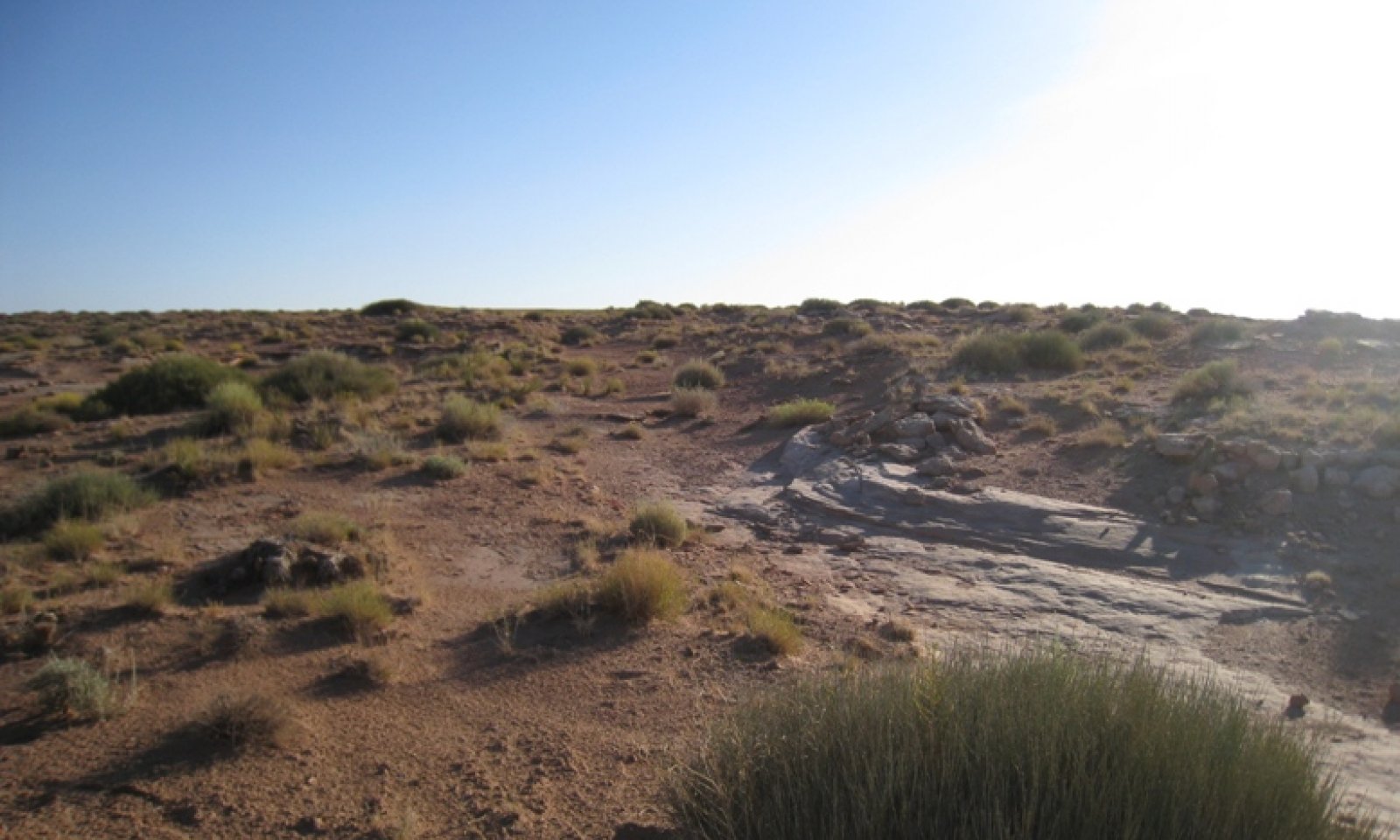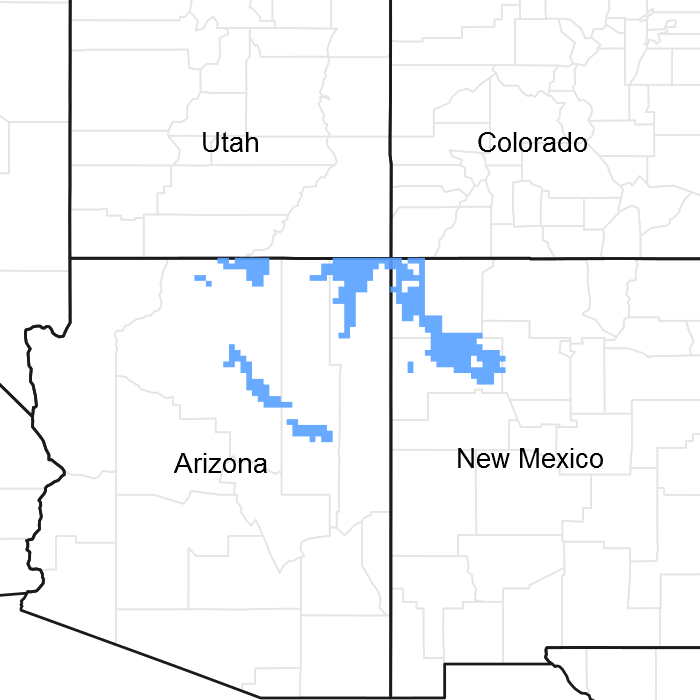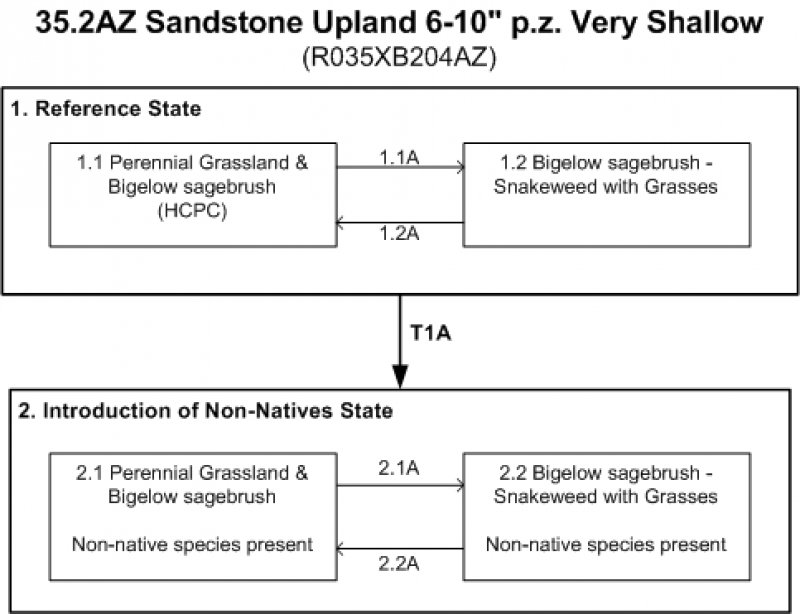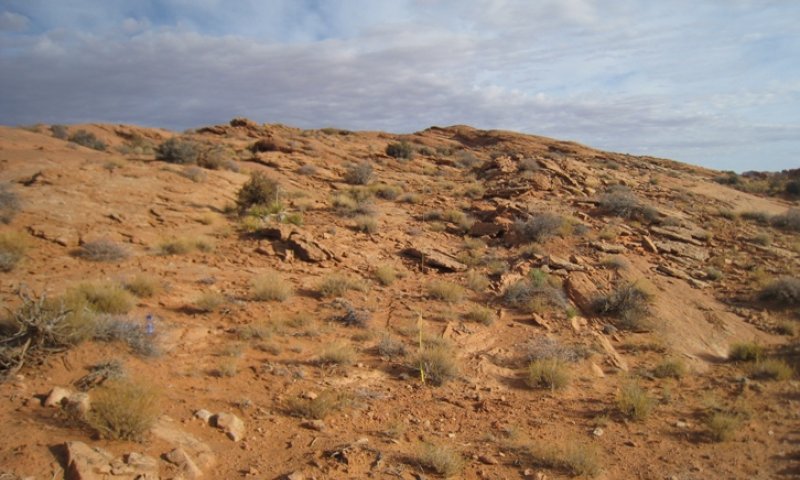

Natural Resources
Conservation Service
Ecological site DX035X04B204
Sandstone Upland 6-10" p.z.
Accessed: 12/20/2025
General information
Provisional. A provisional ecological site description has undergone quality control and quality assurance review. It contains a working state and transition model and enough information to identify the ecological site.

Figure 1. Mapped extent
Areas shown in blue indicate the maximum mapped extent of this ecological site. Other ecological sites likely occur within the highlighted areas. It is also possible for this ecological site to occur outside of highlighted areas if detailed soil survey has not been completed or recently updated.
MLRA notes
Major Land Resource Area (MLRA): 035X–Colorado Plateau
This ecological site occurs in Common Resource Area 35.2 - the Colorado Plateau Shrub – Grasslands
Elevations range from 3800-5800 feet and precipitation averages 6 to 10 inches per year. Vegetation includes shadscale, fourwing saltbush, Mormon tea, blackbrush, Indian ricegrass, galleta, blue grama, and black grama. The soil temperature regime is mesic and the soil moisture regime is typic aridic. This unit occurs within the Colorado Plateau Physiographic Province and is characterized by a sequence of flat to gently dipping sedimentary rocks eroded into plateaus, valleys and deep canyons. Sedimentary rock classes dominate the plateau with volcanic fields occurring for the most part near its margin.
Associated sites
| R035XB201AZ |
Mudstone/Sandstone Hills 6-10" p.z. Shallow sites on slopes of hills, scarps and valley sides |
|---|---|
| R035XB217AZ |
Sandy Upland 6-10" p.z. Deep sandy sites on uplands |
| R035XB219AZ |
Sandy Loam Upland 6-10" p.z. Deep sites with sandy loams on uplands |
Similar sites
| R035XB215AZ |
Sandstone/Shale Upland 6-10" p.z. Shallow site over sandstone/shale on uplands |
|---|---|
| R035XB230AZ |
Sandstone Upland 6-10" p.z. Very Shallow, Warm Calcareous sandy sites shallow to calcareous sandstone |
Table 1. Dominant plant species
| Tree |
Not specified |
|---|---|
| Shrub |
(1) Artemisia bigelovii |
| Herbaceous |
(1) Achnatherum hymenoides |
Legacy ID
R035XB204AZ
Physiographic features
This site occurs on summits of mesas, structural benches, and dipslopes of cuestas on undulating plateaus. Slopes range from 1-15%, with occasional slopes up to 35%. It does not benefit from run-in moisture from adjacent areas nor does it suffer from excessive runoff. It occurs on all exposures. It is associated with sandstone rock outcrops.
Table 2. Representative physiographic features
| Landforms |
(1)
Mesa
(2) Cuesta (3) Structural bench |
|---|---|
| Elevation | 3,800 – 5,800 ft |
| Slope | 1 – 15% |
| Aspect | Aspect is not a significant factor |
Climatic features
The climate of the land resource unit is arid with warm summers and cool winters. Average annual precipitation ranges from 6 to 10 inches per year. 40 to 50 percent of the precipitation is received from October through early May. This precipitation comes as gentle rain or snow from frontal storms coming out of the Pacific Ocean. Snow is common from November through February. Generally no more than an inch or two of snow accumulates and usually melts within a day or two. The remaining precipitation, approximately 50 to 60 percent, is received from July through September as spotty, violent thunderstorms. The moisture for this precipitation originates in the Gulf of Mexico and the Pacific Ocean. Late May through late June is the driest period. The mean annual temperature ranges from 53 to 56 degrees Fahrenheit (F). The frost-free period (air temperature > 32 degrees F) ranges from 135 to 160 days (@ 50 percent probability). Strong winds are common, especially in the spring.
Table 3. Representative climatic features
| Frost-free period (average) | 160 days |
|---|---|
| Freeze-free period (average) | 184 days |
| Precipitation total (average) | 10 in |
Figure 2. Monthly precipitation range
Figure 3. Monthly average minimum and maximum temperature
Influencing water features
Soil features
Soils on this site are very shallow and well drained. They are formed in eolian, residuum and alluvium derived from sandstone. Surface textures include fine sand and channery loamy fine sand. Subsoil has textures of fine sandy loam, channery fine sandy loam, and channery loamy fine sand. Hard sandstone is at depths ranging from 8 to 10 inches. Permeability based on the most restrictive horizon above 20 inches is slow to very slow. Avaiable water capacity is very low. Runoff is medium to very high and the hazard of water erosion is moderate to severe. The hazard of soil blowing is severe. The soils are mildly to moderately alkaline (pH 7.4-8.4), non-saline to very slightly saline (EC 0-4), and non-to slightly sodic (SAR 0-13).
Characteristic taxonomic units are:
Coconino County North Kaibab part(AZ629) Soil Map Units - 30, 31 & 42 Needle;
Navajo County Central Part(AZ633) Soil Map Units - 58;
Little Colorado River Area (AZ707)Soil Map Units - 8 - Leupp.
Navajo Mountain Area (AZ711)Soil Map Units - 45-Needle, 57-Tsaya family;
Chinle Area (AZ713)Soil Map Units - 44-Needle, 47-Needle;29-Moenkopie;
Shiprock Area (AZ-NM)(AZ717) Soil Map Units - 115-Denazin-Farb fine sands (Farb Part), 135-Farb -Rock Outcrop-Badland complex (Farb Part), 205-Shiprock-Farb Complex (Farb Part).
Table 4. Representative soil features
| Parent material |
(1)
Alluvium
–
sandstone
|
|---|---|
| Surface texture |
(1) Fine sand (2) Channery loamy fine sand (3) Gravelly fine sandy loam |
| Family particle size |
(1) Loamy |
| Drainage class | Well drained to somewhat excessively drained |
| Permeability class | Moderately slow to moderate |
| Soil depth | 5 – 10 in |
| Surface fragment cover <=3" | 15 – 20% |
| Surface fragment cover >3" | 5% |
| Available water capacity (0-40in) |
2.5 in |
| Calcium carbonate equivalent (0-40in) |
10% |
| Electrical conductivity (0-40in) |
4 mmhos/cm |
| Sodium adsorption ratio (0-40in) |
13 |
| Soil reaction (1:1 water) (0-40in) |
7.4 – 8.4 |
| Subsurface fragment volume <=3" (Depth not specified) |
5 – 10% |
| Subsurface fragment volume >3" (Depth not specified) |
25% |
Ecological dynamics
An ecological site is not a precise assemblage of species for which the proportions are the same from place to place or from year to year. In all plant communities, variability is apparent in productivity and occurrence of individual species. Spatial boundaries of the communities; however, can be recognized by characteristic patterns of species composition, association, and community structure. The historic climax plant community for this ecological site has been described by sampling relict or relatively undisturbed sites and/or reviewing historic records. The historic climax plant community is the plant community that evolved over time with the soil forming process and long term changes in climatic conditions of the area. It is the plant community that was best adapted to the unique combination of environmental factors associated with the site.
Natural disturbances, such as drought, fire, grazing of native fauna, and insects, are inherent in the development and maintenance of these plant communities. The effects of these disturbances are part of the range of characteristics of the ecological site. Fluctuations in plant community structure and function caused by the effects of natural disturbances help establish the boundaries and characteristics of an ecological site. They are accounted for as part of the range of characteristics of the ecological site. Recognizable plant community phases are identified in the reference state of the ecological site. Some sites may have a small range of variation, while others have a large range. Some plant community phases may exist for long periods of time, while others may only occur for a couple of years after a disturbance.
Deterioration of the plant community, hydrology, or soil site stability on an ecological site can result in crossing a threshold or potentially irreversible boundary to another state, or equilibrium. This can occur as a result of the loss of soil surface through erosion, the loss of the stability of the site due to disturbances that cause active erosion on the site, increases in the amounts and/or patterns or runoff from rainstorms, changes in availability of surface and subsurface water, significant changes in plant structural and functional types, or the introduction of non-native species. When these thresholds are crossed, the potential of the ecological site to return to the historic climax plant community can be lost, or restoration will require significant inputs . There may be multiple states possible for an ecological site, determined by the type and or severity of disturbance.
The known states and transition pathways for this ecological site are described in the state and transition model. Within each state, there may be one or more known plant community phases. These community phases describe the different plant community that can be recognized and mapped across this ecological site. The state and transition model is intended to help land users recognize the current plant community on the ecological site, and the management options for improving the plant community to the desired plant community.
Plant production data provided in this site description is standardized to the air-dry weight of one year's growth. The plant communities described in this site description are based on near normal rainfall years.
State and transition model

Figure 4. Sandstone Upland 6-10" p.z. Very Shallow State and
More interactive model formats are also available.
View Interactive Models
More interactive model formats are also available.
View Interactive Models
Click on state and transition labels to scroll to the respective text
Ecosystem states
State 1 submodel, plant communities
State 2 submodel, plant communities
State 1
Reference State
The plant community on this site is primarily grasses and shrubs with some forbs. There is a mixture of both cool and warm season plants. Plant species most likely to invade or increase on this site when it deteriorates are broom snakeweed, alkali sacaton, shadscale and annual forbs.
Community 1.1
Perennial Grassland and Bigelow Sage

Figure 5. Sandstone Upland 6-10" p.z. Very Shallow

The plant community on this site is primarily perennial grasses and shrubs with some forbs. Dominant grasses are Indian ricegrass and galleta and the dominant shrub is Bigelow sagebrush.
Figure 6. Annual production by plant type (representative values) or group (midpoint values)
Table 5. Annual production by plant type
| Plant type | Low (lb/acre) |
Representative value (lb/acre) |
High (lb/acre) |
|---|---|---|---|
| Grass/Grasslike | 65 | 95 | 155 |
| Shrub/Vine | 30 | 45 | 70 |
| Forb | 5 | 10 | 15 |
| Total | 100 | 150 | 240 |
Figure 7. Plant community growth curve (percent production by month). AZ3521, 35.2 6-10" p.z. all sites. Growth begins in the spring and continues through the summer. Most growth in this CRA occurs in the spring using stored winter moisture..
| Jan | Feb | Mar | Apr | May | Jun | Jul | Aug | Sep | Oct | Nov | Dec |
|---|---|---|---|---|---|---|---|---|---|---|---|
| J | F | M | A | M | J | J | A | S | O | N | D |
| 0 | 1 | 9 | 20 | 27 | 14 | 10 | 11 | 5 | 3 | 0 | 0 |
Figure 8. Plant community growth curve (percent production by month). AZ5201, 35.2 6-10" p.z. galleta. Growth begins in spring, most growth occurs during summer rains..
| Jan | Feb | Mar | Apr | May | Jun | Jul | Aug | Sep | Oct | Nov | Dec |
|---|---|---|---|---|---|---|---|---|---|---|---|
| J | F | M | A | M | J | J | A | S | O | N | D |
| 0 | 0 | 5 | 10 | 20 | 10 | 15 | 35 | 5 | 0 | 0 | 0 |
Figure 9. Plant community growth curve (percent production by month). AZ5202, Indian ricegrass, 35.2 6-10" p.z.. Growth begins in spring, most growth occurs in May, goes dormant during summer heat..
| Jan | Feb | Mar | Apr | May | Jun | Jul | Aug | Sep | Oct | Nov | Dec |
|---|---|---|---|---|---|---|---|---|---|---|---|
| J | F | M | A | M | J | J | A | S | O | N | D |
| 0 | 0 | 10 | 15 | 40 | 20 | 0 | 0 | 10 | 5 | 0 | 0 |
Community 1.2
Bigelow sagebrush - Snakeweed with Grasses
This plant community is characterized by shrubs and scattered perennial grasses. Common shrubs found in this community are Bigelow sage, snakeweed, Greene rabbitbrush, Torrey Mormon tea and shadscale.
Pathway 1.1a
Community 1.1 to 1.2
Unmanaged grazing, wildlife herbivory, drought.
Pathway 1.2a
Community 1.2 to 1.1
Managed grazing, favorable climate/moisture.
State 2
Introduction of Non-Natives State
The plant community in this state is similar to the reference state communities with grasses, shrubs and some forbs; however, with non-native annuals present. There is a mixture of both cool and warm season plants. Plant species most likely to invade or increase on this site when it deteriorates are broom snakeweed, alkali sacaton, shadscale and annual forbs.
Community 2.1
Perennial Grassland and Bigelow Sage w/ Introduced Annuals
The plant community on this site is primarily perennial grasses and shrubs and some forbs with non-native annual species present. Dominant grasses are Indian ricegrass and galleta and the dominant shrub is Bigelow sagebrush.
Community 2.2
Bigelow sagebrush - Snakeweed with Grasses w. Introduced Annuals
Introduced exotic annual grasses and forbs are present in minor amounts in the plant community, but the amount and proportions of native plants is similar to that found in plant community 1.2, Bigelow sagebrush - Snakeweed with Grasses.
Pathway 2.1a
Community 2.1 to 2.2
Unmanaged grazing or wildlife herbivory, drought.
Pathway 2.2a
Community 2.2 to 2.1
Prescribed grazing, favorable climate/moisture.
Transition T1A
State 1 to 2
Unmanaged grazing, drought, herbivory.
Additional community tables
Table 6. Community 1.1 plant community composition
| Group | Common name | Symbol | Scientific name | Annual production (lb/acre) | Foliar cover (%) | |
|---|---|---|---|---|---|---|
|
Grass/Grasslike
|
||||||
| 1 | Grasses | 98–165 | ||||
| Indian ricegrass | ACHY | Achnatherum hymenoides | 30–50 | – | ||
| James' galleta | PLJA | Pleuraphis jamesii | 15–40 | – | ||
| blue grama | BOGR2 | Bouteloua gracilis | 2–20 | – | ||
| squirreltail | ELELE | Elymus elymoides ssp. elymoides | 0–15 | – | ||
| New Mexico feathergrass | HENE5 | Hesperostipa neomexicana | 8–15 | – | ||
| Fendler's threeawn | ARPUF | Aristida purpurea var. fendleriana | 0–10 | – | ||
| alkali sacaton | SPAI | Sporobolus airoides | 0–10 | – | ||
| Grass, perennial | 2GP | Grass, perennial | 0–10 | – | ||
| spike dropseed | SPCO4 | Sporobolus contractus | 0–5 | – | ||
| sand dropseed | SPCR | Sporobolus cryptandrus | 0–5 | – | ||
|
Forb
|
||||||
| 2 | Forbs | 5–15 | ||||
| Forb, perennial | 2FP | Forb, perennial | 0–5 | – | ||
| scarlet globemallow | SPCO | Sphaeralcea coccinea | 2–5 | – | ||
| Forb, annual | 2FA | Forb, annual | 0–3 | – | ||
| Eastwood's sandwort | AREA | Arenaria eastwoodiae | 0–2 | – | ||
| rose heath | CHER2 | Chaetopappa ericoides | 0–2 | – | ||
|
Shrub/Vine
|
||||||
| 3 | Shrubs | 45–70 | ||||
| Bigelow sage | ARBI3 | Artemisia bigelovii | 5–20 | – | ||
| fourwing saltbush | ATCA2 | Atriplex canescens | 0–10 | – | ||
| Shrub (>.5m) | 2SHRUB | Shrub (>.5m) | 0–10 | – | ||
| broom snakeweed | GUSA2 | Gutierrezia sarothrae | 2–10 | – | ||
| shadscale saltbush | ATCO | Atriplex confertifolia | 0–5 | – | ||
| Greene's rabbitbrush | CHGR6 | Chrysothamnus greenei | 0–5 | – | ||
| sand jointfir | EPAR | Ephedra ×arenicola | 0–5 | – | ||
| Torrey's jointfir | EPTO | Ephedra torreyana | 2–5 | – | ||
| narrowleaf yucca | YUAN2 | Yucca angustissima | 0–2 | – | ||
Interpretations
Supporting information
Type locality
| Location 1: San Juan County, NM | |
|---|---|
| Township/Range/Section | T26N R18W S3 |
| General legal description | Table Mesa Quad - 4.5 miles south of Table Mesa, Navajo Reservation, NM. |
Other references
Updates and revisions for this ESD were conducted as part of a 2007-2012 Interagency Technical Assistance Agreement between the Bureau of Indian Affairs–Navajo Region and the NRCS-Arizona.
Contributors
Ken Gishi
Larry D. Ellicott
Michael Carpinelli
Unknown
Rangeland health reference sheet
Interpreting Indicators of Rangeland Health is a qualitative assessment protocol used to determine ecosystem condition based on benchmark characteristics described in the Reference Sheet. A suite of 17 (or more) indicators are typically considered in an assessment. The ecological site(s) representative of an assessment location must be known prior to applying the protocol and must be verified based on soils and climate. Current plant community cannot be used to identify the ecological site.
| Author(s)/participant(s) | Steve Cassady, Rachel Murph, Jennifer Puttere and Ken Gishi |
|---|---|
| Contact for lead author | NRCS State Rangeland Management Specialist, Phoenix, AZ |
| Date | 08/10/2010 |
| Approved by | Byron Lambeth |
| Approval date | |
| Composition (Indicators 10 and 12) based on | Annual Production |
Indicators
-
Number and extent of rills:
None expected. -
Presence of water flow patterns:
Water flow patterns occur, but are generally short in length (<2') and are broken up by bedrock, rock fragments and vegetation. The average spacing of the water flow patterns across the slope is 20 to 30 feet. -
Number and height of erosional pedestals or terracettes:
Some pedestalling does occur, but it is not common and pedestalls are less than 1 inch in height. -
Bare ground from Ecological Site Description or other studies (rock, litter, lichen, moss, plant canopy are not bare ground):
The expected amount of bare ground is infuenced by the amount of bedrock. Bare ground and bedrock combined ranges from 60 to 65 percent. -
Number of gullies and erosion associated with gullies:
None expected. -
Extent of wind scoured, blowouts and/or depositional areas:
None expected. -
Amount of litter movement (describe size and distance expected to travel):
Larger, more persistent litter, such as twigs and branches, does not move. Smaller, less persistent litter, such as grass, forb and shrub leaves, may move short distances (< 2') in the water flow patterns. -
Soil surface (top few mm) resistance to erosion (stability values are averages - most sites will show a range of values):
Soil surface stability values are: Average - 3 to 4; under canopy - 4 to 6; in interspaces - 2 to 3. -
Soil surface structure and SOM content (include type of structure and A-horizon color and thickness):
Soil surface (0 to 2") is yellowish red (5YR 5/6), fine sand, weak thin platy structure in upper 1/4 inch and single grained below. -
Effect of community phase composition (relative proportion of different functional groups) and spatial distribution on infiltration and runoff:
Grass/Grasslike (10 - 15% canopy, 2 - 6% basal); Shrub/Tree (6 - 12% canopy, 0 - 2% basal); Forb (0 - 2% canopy, 0 - 1% basal); Biologic Crust (0 - 2%). -
Presence and thickness of compaction layer (usually none; describe soil profile features which may be mistaken for compaction on this site):
None expected. -
Functional/Structural Groups (list in order of descending dominance by above-ground annual-production or live foliar cover using symbols: >>, >, = to indicate much greater than, greater than, and equal to):
Dominant:
Grass/GrasslikesSub-dominant:
Shrub/Vine/TreeOther:
ForbAdditional:
-
Amount of plant mortality and decadence (include which functional groups are expected to show mortality or decadence):
Mortality of blue grama, galleta, Indian ricegrass, Bigelow sagebrush, Mormon-tea, and other long-lived grasses, forbs and shrubs is < 10% except during prolonged, severe drought events. Expect cyclical higher mortality on shorter lived grasses, shrubs and forbs, such as sand dropseed, squirreltail, broom snakeweed and globemallow. -
Average percent litter cover (%) and depth ( in):
-
Expected annual annual-production (this is TOTAL above-ground annual-production, not just forage annual-production):
The median air-dry production is 150 pounds per acre. Slightly higher production is expected at the highest elevational, highest precipitation areas of the ecological site. Slightly lower production is expected at the lowest elevational, lowest precipitation areas of the ecological site. -
Potential invasive (including noxious) species (native and non-native). List species which BOTH characterize degraded states and have the potential to become a dominant or co-dominant species on the ecological site if their future establishment and growth is not actively controlled by management interventions. Species that become dominant for only one to several years (e.g., short-term response to drought or wildfire) are not invasive plants. Note that unlike other indicators, we are describing what is NOT expected in the reference state for the ecological site:
Species native to the site that have the potential to increase are broom snakeweed, shadscale and annual forbs. Non-native species like Russian thistle and cheatgrass are the most likely to invade after severe disturbance, but minor amounts of either species (< 1%) is expected to be part of the plant community. Filaree is another invasive species that could occur. -
Perennial plant reproductive capability:
The only natural limitations to reproductive capability are weather related and natural disease or herbivory that reduces reproductive capability.
Print Options
Sections
Font
Other
The Ecosystem Dynamics Interpretive Tool is an information system framework developed by the USDA-ARS Jornada Experimental Range, USDA Natural Resources Conservation Service, and New Mexico State University.
Click on box and path labels to scroll to the respective text.